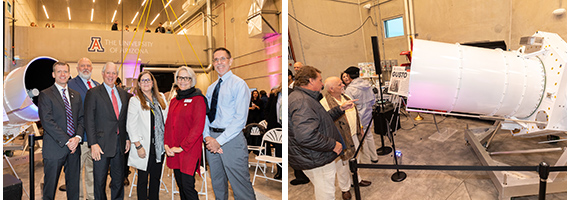
Grand opening of new Mission Integration Lab for balloon-borne astronomy
The University of Arizona on Monday celebrated the opening of the Mission Integration Lab, a new research building in the UA Tech Park at The Bridges that will accommodate testing and preparation for balloon-borne astronomy missions.
Balloon-borne astronomy fills an important niche between ground-based observatories and space telescopes, allowing for the deployment of telescopes and other instruments to altitudes where they experience less interference from Earth's atmosphere. Modern balloon-borne observatories offer space-like views of the universe at a fraction of the time and cost of a full space mission.
The Mission Integration Lab provides a tall, hangar-like space, known as a "high bay," which allows researchers to prepare and test balloon payloads and other space payloads before their flights.
The Monday event featured remarks from University of Arizona President Robert C. Robbins; Elizabeth "Betsy" Cantwell, UArizona senior vice president for research and innovation; and Carol Stewart, vice president for Tech Parks Arizona.
Equipment was on display from two balloon-borne missions:
- The Terahertz Intensity Mapper, a NASA-funded balloon mission designed to create a giant map of galaxies from over 5 billion years of cosmic history. The mission relies on an imaging spectrometer capable of detecting extremely faint galaxies in the "cosmic afternoon," the time when star formation in the universe was slowing down from its peak 10 billion years ago.
- GUSTO, short for Galactic/Extragalactic ULDB Spectroscopic Terahertz Observatory, a NASA-funded mission to carry an infrared telescope to study the lifecycle of stars in the interstellar medium.

For Public
Public events include our Monday Night Lecture Series, world-reknowned Astronomy Camp and Mt Lemmon Sky Center.

For Students
A good place to start if you want to become an undergrad major or grad student, or need to find our schedule of classes.

For Scientists
Find telescopes and instruments, telescope time applications, staff and mountain contacts, and faculty and staff scientific interests.




